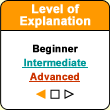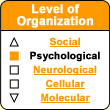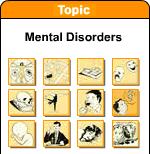|
|
| Funding for this site is provided by readers like you. | |
|
|
|
|
|||||
|
|
|||||||
|
|
|
|
|
|
Free Radicals and Aging: More Complicated Than We Thought Donating Your Brain to Science Memory Loss in Alzheimer’s Reduced for the First Time
|
|
The brain, like the rest of the human body, changes throughout a person’s lifetime. After the brain’s rapid, spectacular development in the earliest years of life, its plasticity decreases and the changes slow, but they continue for as long as a person is alive. As people age, however, it is not unusual for them to experience a gradual decline in their intellectual faculties, and in particular their memory. This is a natural phenomenon associated with normal aging of the brain (follow the Tool Module link to the left). But in some people, this decline happens much faster, with disastrous consequences in their lives and the lives of their families. The general term for this phenomenon, dementia, was first used in the early 19th century. At that time, dementia was regarded as a form of what was called “mental alienation”, which also included schizophrenia and mood swings. And because the most serious symptoms were most often seen in elderly people, the expression “senile dementia” also came into use (it is now used less and less). Today, various types of dementia are distinguished (see second sidebar), but all have a common definition that, on the basis of World Health Organization diagnostic criteria, may be stated as follows: “a gradual loss of memory and of the ability to form and organize ideas, severe enough to interfere with activities of daily living, and present for at least six months”. The cognitive and social problems associated with dementia result not from psychiatric disorders, but rather from organic causes that have been well characterized: specifically, an abnormally high number of neurons deteriorating and dying in certain parts of the brain. In this sense, the various forms of dementia are part of the broader category of neurodegenerative diseases (see box below).
Cognitively, individuals may experience memory problems. They may often repeat the same question, or buy the same thing twice. They may become disoriented, wandering around their own neighbourhood for hours, or lose their sense of time. They may become confused if they have to attempt tasks that require abstract planning, such as running errands or making transfers when travelling by public transit. Linguistically, to compensate for having forgotten specific words, people with dementia tend to use catch-all terms like “thingy” or “gizmo”. They may also have problems in remembering important dates such as birthdays, or the names of famous people. Their motor skills may also be impaired when they try to operate familiar household appliances. Emotionally, people with dementia may become sad, unstable, or even verbally or physically aggressive. They may act socially disinhibited and overfamiliar at some times, and fearful or suspicious at others, or they may experience episodes of euphoria, depression, or anxiety. Behaviourally, people with dementia show less interest in other people, lose contact with their friends, and gradually give up their leisure pastimes. Often their movements become slower, which can, for example, make it hard for them to drive a car, or simply to comb their hair or brush their teeth. The best known form of dementia is Alzheimer’s-type dementia, commonly known as Alzheimer’s disease. It is also the most widespread form, accounting for 60 to 65% of all dementia cases. Alzheimer’s-type dementia affects the brain only. And within the brain, it is the thin layer of grey matter, the cortex, that is affected. In this type of dementia, the first observable deficits begin in the hippocampus and the entorhinal cortex, two parts of the brain that are relatively old in evolutionary terms and that are involved in memory, so these deficits take the form of memory disorders. Subsequently, other functions become impaired as well, such as language, orientation in time and space, the ability to plan activities, the ability to recognize faces and objects, and so on. People with Alzheimer’s-type dementia may also experience mood swings and become apathetic or depressed. At the severe stage of the disease, they become so confused and their movements become so laboured that they no longer have the skills needed to carry out their activities of daily living (washing, dressing, eating, and so on) on their own. Though scientists do not yet know how to stop the progress of Alzheimer’s-type dementia, much less cure it, various medications and other treatments can relieve some symptoms and improve the quality of life of individuals who have it (follow the advanced Tool Module link to the left). This is also an area in which a great deal of research is being done. Some studies have revealed two major degenerative processes that are associated with neuronal death. The traces that these two processes leave outside and inside the neurons were described for the first time by German physician Alois Alzheimer in 1906 (follow the beginner History Module link to the left).
|
|
|||||||||||||||||||||||||||||||||||||||||||||||||||||||||||||||||||||||||||
|
For many diseases, the precise cause is known. For example, measles is caused by a virus, tuberculosis by a bacterium, and malaria by a protozoan. But as with many other chronic conditions, there is no clearly identifiable cause of Alzheimer’s. Instead, the consensus is that this type of dementia develops under the influence of several factors. These risk factors may combine to overwhelm the natural mechanisms by which the brain repairs itself. A cascade of biochemical reactions then occurs, leading, years later, to the apperance of the earliest symptoms of Alzheimer’s. These risk factors are specific to each individual, but they can be divided into three main categories. First, there are familial factors—the genes that we inherit from our parents. These factors can give members of certain families a predisposition to develop Alzheimer’s. In the rare “familial” form of Alzheimer’s, these genetic factors will have an even more direct effect. The next category consists of environmental factors. For many decades, scientists believed that Alzheimer’s developed as the result of some environmental factor, such as a virus, a bacteria, or a toxic substance (in particular, aluminum—see sidebar). But one by one, these purely environmental hypotheses were discarded. Nonetheless, we do know today that the environment in the broad sense (diet, levels of stress, intellectual stimulation, physical exercise, and so on) does influence the development of Alzheimer’s. And for people with Alzheimer’s, a healthy, stimulating lifestyle gives them the best chance at a better quality of life.
Lasty, as we age, the interaction between our heredity and our environment leads to actual physiological disturbances in our bodies, such as chemical imbalances, immune deficiencies, an excess of toxic free radicals, and malformed proteins that disrupt the internal functioning of neurons or that become toxic by building up around them. Though none of these disturbances is the ultimate cause of Alzheimer’s, each of them leads to problems in neuronal communication that help to make it worse. As so often happens in science, various hypotheses to try to explain the mechanisms behind Alzheimer’s have made one or the other of these disturbances their central focus. For example, the cholinergic hypothesis, which is one of the oldest, was the basis for most of the medications that have been developed to treat Alzheimer’s (follow the advanced Tool Module link to the left ). According to this hypothesis, Alzheimer’s is caused by insufficient synthesis of the neurotransmitter acetylcholine. But this hypothesis has become less popular, among other reasons because of the limited effectiveness of Alzheimer’s medications that attempt to compensate for acetylcholine deficiencies. The amyloid hypothesis, first advanced in the early 1990s, is that deposits of amyloid plaques between the neurons are the primary cause of Alzheimer’s. This hypothesis is based, among other things, on the fact that type 4 of the apolipoprotein E gene, which is a recognized risk factor for Alzheimer’s, leads to overproduction of the amyloid fragment from which plaques form. This hypothesis continues to dominate much Alzheimer’s research, even though it has been subject to growing criticism. The tau hypothesis has received increased suppport, especially since a study in 2004 showed that there were no clear correlations between deposits of amyloid plaques and loss of neurons. The name of this hypothesis refers to the name of a protein located in the neuron’s axon. In Alzheimer’s, this protein assumes abnormal forms, thus preventing the axon’s transportation system from working, impairing the neuron’s communication functions,
and eventually causing it to die. According to the tau hypotheis, this cascade of events is the cause of Alzheimer’s. |
| |
|
|
|
|
|
|
|
|






